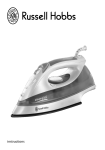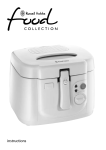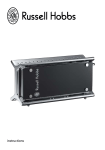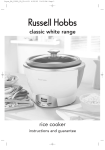Download Russell Hobbs MAX-I-SWANN SW-U-WC202P User's Manual
Transcript
instructions 2 Read the instructions and keep them safe. If you pass the appliance on, pass on the instructions too. Remove all packaging, but keep it till you know the appliance works. important safeguards Follow basic safety precautions, including: 1 This appliance must only be used by or under the supervision of a responsible adult. Use and store it out of reach of children 2 Don’t put the appliance in liquid, don’t use it in a bathroom, near water, or outdoors. 3 Route the cable so it doesn’t overhang, and can’t be tripped over or caught. 4 Don’t iron clothing while it’s being worn – you’ll burn or scald the wearer (this is not a joke – I’ve seen it happen). 5 Don’t touch the soleplate, and keep away from the steam coming from it. 6 Don’t use the iron in the vicinity of children. 7 Sit the base unit on a stable, level, heat-resistant surface, preferably a purpose-built “steam generator” type ironing board. 8Don’t sit the base unit on a soft, carpeted, or upholstered surface, as this may block the vents underneath the base unit. 9 Use the iron on a stable, level, heat-resistant surface, preferably an ironing board. 10 Don’t leave the iron unattended while plugged in, or while it’s standing on the ironing board. It could be knocked over by you, by a child, or by a pet. 11 Unplug before filling, before cleaning, and after use. 12 Don’t fill past the max mark on the reservoir, or water may escape in use. 13 Unplug the appliance when not in use, before moving and before cleaning. Let it cool down fully before cleaning and storing away. 14 Don’t fit any attachment or accessory other than those we supply. 15 Keep the cables and steam pipe away from hot parts. 16 Keep the appliance and the cable away from hotplates, hobs or burners. 17 Don’t use the iron for any purpose other than those described in these instructions. 18 Take care not to scratch the soleplate – avoid buttons, zips, etc. 19 The appliance has a protective thermal fuse, which will blow if it overheats. If this happens, the appliance will stop working, and must be returned for repair. 20Don’t operate the appliance if it’s dropped or damaged or if it malfunctions or leaks. 21If the cable is damaged, the appliance must be returned, in order to avoid hazard. household use only before using for the first time • Remove any labels, stickers or packaging from the iron and soleplate. • Don’t worry if the iron smokes a bit at first, it’ll stop as the element cures. • Iron an old piece of cotton fabric, to clean the soleplate. preparation 1 Check for textile care symbols (i j k l). 2 Iron fabrics needing low temperatures j first, then those that need medium temperatures k, and finish with those needing high temperatures l (or max). 3 Sit the base on the end of the ironing board, and put the iron on the base. 3 filling 4 You may fill the reservoir with tap-water, but if you live in a hard-water area, you should use distilled water (not chemically descaled or softened water). 5 If you buy distilled water, check that it’s marketed as suitable for irons. 6 Don’t put anything in the water. 7 Unplug the base. 8To remove the reservoir from the base: a) face the front of the reservoir b)put your thumbs on the fronts of the top tabs on either side of the base c) put your forefingers on the backs of the bottom tabs on either side of the reservoir d)gently press against the top tabs, and pull the bottom tabs towards you e) The reservoir will slide out from the base. 9 Flip up the cap at the front of the reservoir, and fill to max with fresh cold water. 10 Don’t fill past max, or water will escape in use. 11 Slide the reservoir back into the base, and check that the top and bottom tabs are within 2 mm of each other. 12 Alternatively, you may prefer to leave the reservoir in place, and fill it with a jug. It holds a bit more than one litre. ,Try not to let the reservoir run dry while the iron is in use. switch on 13 Put the iron on the base – the lumpy bits on top are heat-resistant. 14 Turn the temperature control to • or higher, so the thermostat can operate. 15 Put the plug into the power socket (switch the socket on, if it’s switchable). 16 The ready light will come on, to show that the iron is heating up. 17 When the ready light goes off, the iron has reached the temperature you set. temperature setting guide 18 Turn the temperature control to bring the setting you want next to the mark. ,If you want to use steam, you must set the temperature to S or higher, or you’ll just get water. 19 The thermostat light will go on and off as the thermostat operates to maintain the temperature. We suggest you ignore it, and carry on ironing. label marking temperature setting j cool – nylon, acrylics, polyester • k warm – wool, polyester mixtures •• l hot – cotton, linen ••• denim/jeans max i do not iron ,If the instructions on the fabric label differ from this guide, follow the instructions on the label. 4 reducing temperature 20If you’ve missed something, remember that reducing the temperature takes a lot longer than raising it. 21You must wait till the ready light comes on, then goes off again, to ensure that the iron has come down to the correct temperature. steam ironing ,Water spotting affects some fabrics. Test this out on a hidden part of the fabric. 22Check that there’s water in the reservoir. 23Set the temperature control to S or higher, or you’ll just get water. 24Wait till the thermostat light goes out. prime the iron a) squeeze the trigger and hold it in b)it may take a minute or so for the steam to reach the iron c) you’ll hear the pump throbbing d)the note will change, and steam will come from the soleplate 25Press the trigger for steam, release the trigger to stop the steam. 26Try not to let the reservoir run dry while the iron is in use, or you’ll have to prime it again after refilling. 27Don’t hold the trigger for more than 3 minutes, or water may drip on the fabric. You wouldn’t normally iron part of a garment for anything like 3 minutes, but you can get carried away when you’re ironing vertically – especially with curtains. ,Steam may still escape from the iron after the trigger has been released. This is normal, don’t worry about it. dry ironing 28You can dry iron by not squeezing the trigger. 29If you want to make sure you don’t accidentally squeeze the trigger, empty the reservoir, bring the temperature to above S, then squeeze the trigger a few times to get rid of any steam left in the iron or the pipe. spray ,Water spotting affects some fabrics. Test this out on a hidden part of the fabric. 30This works with dry or steam ironing, as long as there’s water in the atomiser bottle. 31Check that the atomiser bottle contains water. 32Lift the iron off the fabric. 33Aim the spray nozzle at the fabric. 34Press the * button. atomiser a) hold the atomiser by the grips on either side, and lift it up and off the iron b)pull the bottle down, to free it from the atomiser c) fill the bottle with water, but not to the brim d)align the arrows on the back of the bottle and atomiser e) lower the tube into the bottle f) stop when the rim of the bottle fits inside the atomiser g)align the tabs underneath the atomiser with the slots in the iron h)lower the atomiser and bottle into the front of the iron 5 vertical steaming 35Remove wrinkles from hanging clothes, hanging curtains, and furnishing fabrics. 36Check that there’s adequate ventilation behind the fabric, otherwise moisture may build up, causing mildew. 37Check that there’s nothing behind the fabric that may be damaged by the steam. 38Check that pockets, turn-ups, and cuffs are empty. 39Check that there’s water in the reservoir. 40Check that the temperature control is at S or higher. 41Wait till the thermostat light goes out. 42Hold the iron close to (but not touching) the fabric. 43Press the trigger to produce steam. 44Don’t squeeze and hold the trigger for more than 3 minutes or water may drip on the fabric. You wouldn’t normally iron a garment for anything like 3 minutes, but you can get carried away when you’re ironing vertically – especially with curtains. no water 45If you press the trigger when there’s no water in the reservoir, the pump will make a lot of noise. 46Stop pressing the trigger, then: a) dry iron or b)fill the reservoir, prime the iron, and carry on steam ironing holidays 47If you’re going to leave the iron for more than a week, it’s best to empty the reservoir, to avoid mould. 48Leave the iron to cool down completely. 49Remove the reservoir, flip open the cap, and empty it via the filling hole. 50Wipe off any excess moisture, then replace the reservoir in the base unit. care and maintenance cleaning 1 Unplug the appliance when not in use, before moving and before cleaning. Let it cool down fully before cleaning and storing away. 2 Wipe outer surfaces with a damp cloth. If necessary, use a little washing-up liquid. 3 Remove spots from the soleplate with a little vinegar. 4 Take care not to scratch the soleplate. 5 Don’t put the appliance in water or any other liquid. 6 Don’t use harsh or abrasive cleaning agents or solvents. 6 descale regularly 1 Descale regularly, (at least monthly) to keep your iron in good working order. 2 You can use commercial descaler – make sure it’s suitable for products with plastic parts, and follow the instructions on the packet. 3 Tartaric acid will do the job just as well. If your local supermarket doesn’t have tartaric acid, you should be able to get it from a home-brew supply shop, pharmacy, or confectioners. If you can get citric acid, you may use that instead. a) Dissolve 1½-2 teaspoons of tartaric acid in half a litre of warm water. b)When it’s fully dissolved, pour it into the reservoir. c) Hold the iron over a basin or sink. d)Prime it, set it to high steam #, then use the trigger to run steam through the iron till the tartaric acid solution is almost done (don’t worry about the last few drops). e) Rinse the reservoir with fresh water, then fill with about half a litre of fresh water. f) Hold the iron over a basin or sink. g)Prime it, set it to high steam #, then use the trigger to run steam through the iron till the reservoir is almost empty (again, don’t worry about the last few drops). what to watch for • Keep an eye on the steam output. If this reduces substantially, then it may be time to descale the iron. • Look out for flecks of scale on your clothes. If scale is building up inside the iron, then flecks will peel off, and make their way through to the soleplate. If you see any, then descaling may be due. ,Products returned under guarantee with faults due to scale will be subject to a repair charge. 7 connection The product must be earthed. It has a 13A BS1362 fuse in a 13A BS1363 plug. To replace the plug, fit the green/yellow wire to E or E, the blue wire to N, and the brown wire to L. Fit the cord grip. If in doubt, call an electrician. Don’t use a non-rewireable plug unless the fuse cover is in place. If you remove the plug, dispose of it. wheelie bin symbol To avoid environmental and health problems due to hazardous substances in electrical and electronic goods, appliances marked with this symbol mustn’t be disposed of with unsorted municipal waste, but recovered, reused, or recycled. service If you ring Customer Service, please have the Model No. to hand, as we won’t be able to help you without it. It’s on the rating plate (usually underneath the product). The product isn’t user-serviceable. If it’s not working, read the instructions, check the plug fuse and main fuse/circuit breaker. If it’s still not working, consult your retailer. If that doesn’t solve the problem – ring Customer Service – they may be able to offer technical advice. If they advise you to return the product to us, pack it carefully, include a note with your name, address, day phone number, and what’s wrong. If under guarantee, say where and when purchased, and include proof of purchase (till receipt). Send it to: Customer Service, Salton Europe Ltd, Failsworth, Manchester M35 0HS email: [email protected] telephone: 0845 658 9700 (local rate number) guarantee Defects affecting product functionality appearing within one year of purchase will be corrected by replacement or repair provided the product is used and maintained in accordance with the instructions. Your statutory rights are not affected. Documentation, packaging, and product specifications may change without notice. online 550-349 www.russellhobbs.co.uk for more products 8













